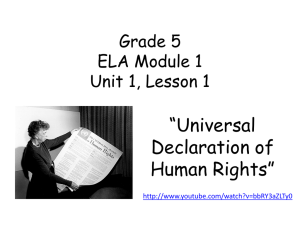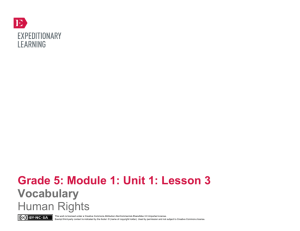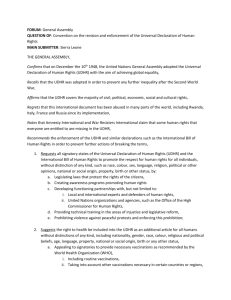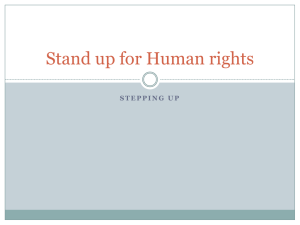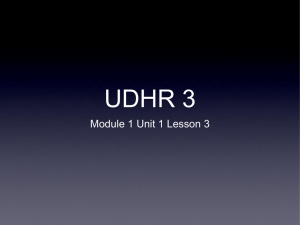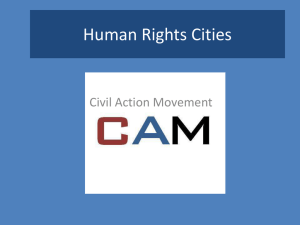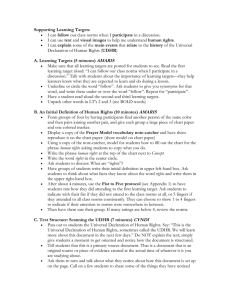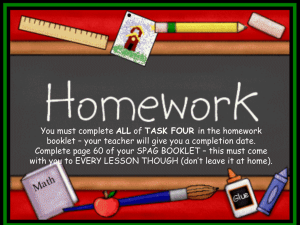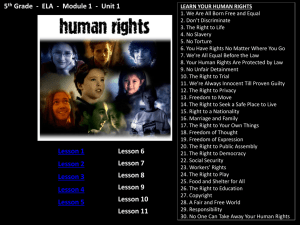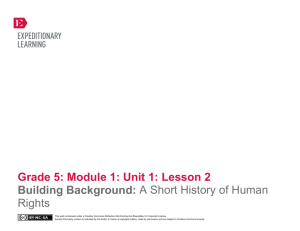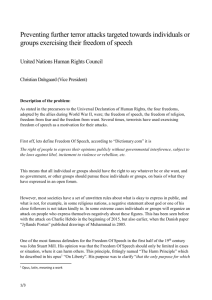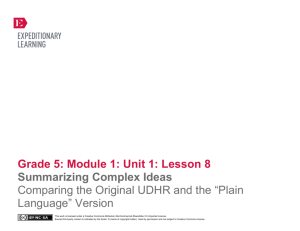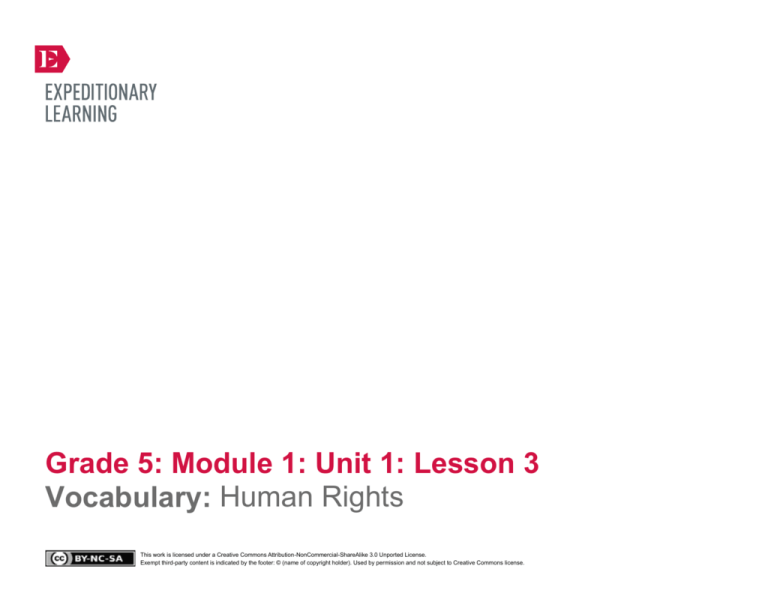
Grade 5: Module 1: Unit 1: Lesson 3
Vocabulary: Human Rights
This work is licensed under a Creative Commons Attribution-NonCommercial-ShareAlike 3.0 Unported License.
Exempt third-party content is indicated by the footer: © (name of copyright holder). Used by permission and not subject to Creative Commons license.
GRADE 5: MODULE 1: UNIT 1: LESSON 3
Vocabulary:
Human Rights
Long-Term Targets Addressed (Based on NYSP12 ELA CCLS)
I can determine the main idea(s) of an informational text based on key details. (RI.5.2)
I can use a variety of strategies to read grade-appropriate words and phrases I don’t know. (RL.5.4)
I can determine the meaning of academic words or phrases in an informational text. (RI.5.4)
I can determine the meaning of content words or phrases in an informational text. (RI.5.4)
Supporting Learning Targets
Ongoing Assessment
• I can use context clues to help me determine the meaning of words.
• I can draw visuals to represent human rights vocabulary words.
• Students’ annotated copies of “A Short History of the
UDHR” (homework from Lesson 2)
• I can write to help me deepen my understanding about human rights.
• Students’ annotated texts “Background on the UDHR”
• Vocabulary sketches (on flash cards)
Agenda
Teaching Notes
1. Opening
• For Work Time, the focus is on how to make and use flash cards. Thus, dictionary work is omitted in the
interest of time. The teacher asks students if they know definitions of a few key words that are hard to
figure out in context, and then provides definitions. In other lessons, it is certainly appropriate to have
students use a good juvenile dictionary or CoBuild, an online student-friendly dictionary.
A. Reviewing Learning Targets (5 minutes)
B. Engaging the Reader: Background on the UDHR
(10 minutes)
2. Work Time
A. Rereading, Using Context Clues to Determine Word
Meaning, and Making Vocabulary Flash Cards
(35 minutes)
3. Closing and Assessment
• Some students may benefit from instruction or review of these words: use, experiment, draw.
• The text “Background on the UDHR” is just one short paragraph taken from a Web site. See supporting
materials for specific directions about how to locate this specific paragraph on the more comprehensive
Web site. Students will need access to just the first paragraph from the section titled “The Universal
Declaration of Human Rights” at this Web site.
• Review: Think-Pair-Share protocol (see Appendix).
• Post: Learning targets.
A. Routine Writing (10 minutes)
4. Homework
Copyright © 2013 by Expeditionary Learning, New York, NY. All Rights Reserved.
NYS Common Core ELA Curriculum • G5:M1:U1:L3 • March 2014 •
1
GRADE 5: MODULE 1: UNIT 1: LESSON 3
Vocabulary:
Human Rights
Lesson Vocabulary
Materials
draw, deepen, context, human rights,
vocabulary, visual, meaningful,
dignity, endowed, conscience,
articulated, horrific, amid, grinding,
sought, aspirations, entitled
• A Short History of the UDHR: Complete Version (from Lesson 2)
• “Background on the UDHR” (one per student)
• Introduction to the UDHR (from Lesson 1)
• Index cards
• Markers or colored pencils
• Plastic zip bags (quart size)
• Document camera or interactive white board
Opening
Meeting Students’ Needs
A. Reviewing the Learning Targets (5 minutes)
• Consider providing nonlinguistic
symbols (e.g., a stick figure person
for human, a magnifying glass for
clues, a pencil for write) to assist
ELLs in making connections with
vocabulary. These symbols can be
used throughout the year.
• Remind students that they have begun to discuss the concept of human rights.
• Say: “Human rights is a big idea. There are a lot of words and concepts we don’t know or understand associated with this
concept. Today we will take a deeper look at words that will help us understand more about human rights. We will do this by
practicing ways to figure out what new words mean.”
• Ask a few students to read aloud the posted learning targets one at a time. Have the class think about which words are
common to all three learning targets. Circle or underline their responses.
• Say: “When words are repeated, that often indicates that they are important. Words about human rights are what today is all
about.”
• Using the Think-Pair-Share protocol, have students identify the verbs in each learning target: what they will be doing with
the words. Choose a few partners to share out.
• Underline or circle the words draw, use, deepen. Choose a student to pantomime drawing something. Repeat with use and
deepen. (Since use and deepen are more abstract concepts, ask students for and write synonyms underneath or above these
words.)
Copyright © 2013 by Expeditionary Learning, New York, NY. All Rights Reserved.
NYS Common Core ELA Curriculum • G5:M1:U1:L3 • March 2014 •
2
GRADE 5: MODULE 1: UNIT 1: LESSON 3
Vocabulary:
Human Rights
Opening
Meeting Students’ Needs
B. Engaging the Reader: Background on the UDHR (10 minutes)
• Provide ELLs bilingual word-forword translation dictionaries or
online translation sources such as
Google Translate to assist with
comprehension. ELLs should be
familiar with how to use glossaries
or dictionaries. These are an
accommodation provided to ELLs
on NY State assessments.
• Remind students that during Lesson 2, they learned some basic information about when the UDHR was written and why.
Ask them to refer to their copies of A Short History of the UDHR: Complete Version. Invite them to turn and talk with a
partner about one thing they remember from what they read or talked about.
• Explain that today they are going to look at another short text about the history of the UDHR. They will work hard to figure
out what it means, focusing in on important words.
• Distribute the new excerpt: “Background on the UDHR” (see supporting materials).
• Read the text aloud slowly as students follow along. Then ask students to reread the text on their own, thinking about the
main idea. Ask them to turn and talk with a partner about what they understand and what words or phrases still confuse
them. Invite a few students to share out, focusing on the words and phrases they don’t understand.
• Today, they will focus on some ways to learn and figure out hard vocabulary. This will help them not only as they are
learning about human rights, but any time they read challenging text.
Copyright © 2013 by Expeditionary Learning, New York, NY. All Rights Reserved.
• Consider partnering an ELL with a
student who speaks the same home
language when discussion of
complex content is required. This
can let students have more
meaningful discussions and clarify
points in their home language.
NYS Common Core ELA Curriculum • G5:M1:U1:L3 • March 2014 •
3
GRADE 5: MODULE 1: UNIT 1: LESSON 3
Vocabulary:
Human Rights
Work Time
Meeting Students’ Needs
A. Rereading, Using Context Clues to Determine Word Meaning, and Making Vocabulary Flash Cards (35
minutes)
• Distribute several index cards to each student. Have the UDHR note-catchers from Lesson 1 close at hand, since students
will need them about halfway through Work Time.
• Use vocabulary learning strategies
to support all learners: prefixes,
root words, suffixes, cognates, and
context.
• Say: “There are a lot of really hard words in the very short piece of text I just read out loud. We are going to practice finding
the meaning of new vocabulary words just from what’s around them or from the meaning of what you are reading about, or
the ‘context.’ It’s important to be able to figure out words from context because it slows you down a lot as a reader if you
have to stop and look up everything in a dictionary.”
• Students who have an above-gradelevel vocabulary can add a sentence
with the new vocabulary word in
context.
• Ask students to read the short excerpt “Background on the UDHR” for a third time, silently looking for new words that help
them understand what human rights are or that might help them if they knew what they meant. Students should underline
these words and share them with a partner.
• Allowing ELLs to use a bilingual
dictionary or translator may assist
them in understanding some words.
• Reread the first sentence aloud. Ask a student to share a word he or she underlined. Listen for words and phrases that will
help students understand human rights, such as: human family and articulated.
• Working with two to three words at
a time allows students who struggle
with language to gradually increase
their vocabulary.
• Say: “Sometimes we are able to find the meaning of new words from the clues around the word. Sometimes you have to read
the sentences before and after the one where the new word is.”
• Using articulated, show students how to go back to the text and reread the sentence, looking for words around the new one
that could help them to determine the meaning.
• Say: “First you have to figure out what part of speech the word is, because it tells us what that word is referring to.
Articulated is a verb, a doing word. What thing was articulated?”
• Take suggestions from students. Listen for someone to suggest “rights” or “the UDHR.” Say:
* “Yes, it has something to do with the rights and the UDHR. So, what could have happened with the rights in 1948?”
• Again, take suggestions from the students and look for answers such as: “they were thought of” or “someone wrote them
down.” Say: “Good! You are using context clues to make logical inferences about what articulated means. It means ‘clearly
stated or said.’”
• Model and have students write that synonym above or below the word articulated in the paragraph.
Copyright © 2013 by Expeditionary Learning, New York, NY. All Rights Reserved.
NYS Common Core ELA Curriculum • G5:M1:U1:L3 • March 2014 •
4
GRADE 5: MODULE 1: UNIT 1: LESSON 3
Vocabulary:
Human Rights
Work Time (continued)
Meeting Students’ Needs
• Then have students write the word articulated on an index card and the synonym (“clearly stated”) on the back of the same
index card. Tell them they have just started flash cards that they can use to study and learn new words. Tell them their
brains remember words better when they have pictures to remind them of the meaning.
• Increased interactions with
vocabulary in context increase the
rate of vocabulary acquisition for
ELLs.
• Now have students visualize the word articulated in their minds and draw a picture of their visualization on the same side as
the synonym.
• Ask:
* “Which other words in this text would be most important to help us know more about human rights and the UDHR?”
• ELL language acquisition is
facilitated by interacting with native
speakers of English who provide
models of language.
• Call on a few students to share their thoughts aloud. Students likely will mention the following; if not, probe. As they name
these words, help them think aloud about the meaning of each one using context. As you and they arrive at a definition, list it
on an interactive white board or document camera:
– horrific = terrible
– amid = with or in
– grinding = really bad or intense
– sought (past tense of the verb “to seek”) = looked, wanted to
– aspirations = positive wishes for the future; positive goals (since it is in a list with hopes)
– entitled = deserves
• Then tell students that they are going to make flash cards for a few important words from Article 1 of the UDHR.
• Ask students to look at their copy of the Introduction to the UDHR.
• Focus first on the word dignity. Point out to students that some words are hard to figure out from context. Sometimes you
just need to be told the definition, or look it up in a dictionary.
• Have students write the word on one side of an index card. Ask students to think, then talk with a partner, about the word.
Does one person in the pair remember or have written down what dignity means from Lesson 1?
• Ask a volunteer to share out a synonym if some students are struggling. Listen for responses like: “respect” or “worth.” If no
students can come up with a synonym, provide the class with the definition that you provided in Lesson 1: “the state of being
valued and worthy of respect.”
Copyright © 2013 by Expeditionary Learning, New York, NY. All Rights Reserved.
NYS Common Core ELA Curriculum • G5:M1:U1:L3 • March 2014 •
5
GRADE 5: MODULE 1: UNIT 1: LESSON 3
Vocabulary:
Human Rights
Meeting Students’ Needs
Work Time (continued)
• Have students turn the card over and write the synonym. Next to their synonym, have students draw a picture to represent
that word.
• Place students in triads to do the same with their remaining words from Article 1, including:
– endowed = given
– conscience = an inner sense of right and wrong
• If there is time, ask students to make flash cards for the rest of the words you have listed on the board. Circulate among the
groups, noting if you need to call the class back together to help with any particularly difficult words.
• For each word, choose a student who has done the task correctly to replicate her or his card on the board. Explain to
students that they will be adding to their set almost daily as they study human rights.
• Ask students to talk about words they figured out from context versus the words they needed you to help them define. Ask:
* “How does a reader know when he is stuck and can’t get a word from context?”
• Ask students to store their flash cards in a baggie. Ask them to finish (for homework) the drawings on any cards they did
not complete during class.
• Collect or ask students to put away their UDHR note-catchers and A Short History of the UDHR for further use.
Copyright © 2013 by Expeditionary Learning, New York, NY. All Rights Reserved.
NYS Common Core ELA Curriculum • G5:M1:U1:L3 • March 2014 •
6
GRADE 5: MODULE 1: UNIT 1: LESSON 3
Vocabulary:
Human Rights
Closing and Assessment
Meeting Students’ Needs
A. Routine Writing: (10 minutes)
• Consider allowing struggling
students to draw their observations,
ideas, or notes when appropriate.
• Read aloud the learning targets. Ask students to rank themselves, using the Fist to Five strategy, on the first target:
* “I can use context clues to help me determine the meaning of words.”
• Ask students to write on their “Background on the UDHR” text:
* “The first time I read this, I thought … But now I know …”
• After about 6 minutes of writing, have students share what they wrote with a partner.
• Collect students’ writing to check in on their growing understanding and to identify any misconceptions that may need to be
addressed in future lessons.
Homework
• For students who need additional
support, consider offering a
sentence frame, sentence starter, or
cloze sentence to assist with
language production and provide
the structure required.
Meeting Students’ Needs
• Finish your vocabulary flash cards.
Copyright © 2013 by Expeditionary Learning, New York, NY. All Rights Reserved.
NYS Common Core ELA Curriculum • G5:M1:U1:L3 • March 2014 •
7
Grade 5: Module 1: Unit 1: Lesson 3
Supporting Materials
This work is licensed under a Creative Commons Attribution-NonCommercial-ShareAlike 3.0 Unported License.
Exempt third-party content is indicated by the footer: © (name of copyright holder). Used by permission and not subject to Creative Commons license.
GRADE 5: MODULE 1: UNIT 1: LESSON 3
Background on the UDHR
Rights for all members of the human family were first articulated in 1948 in the United Nations’
Universal Declaration of Human Rights (UDHR). Following the horrific experiences of the Holocaust
and World War II, and amid the grinding poverty of much of the world’s population, many people
sought to create a document that would capture the hopes, aspirations, and protections to which every
person in the world was entitled and ensure that the future of humankind would be different.
Excerpted from “Human Rights: Here & Now,” edited by Nancy Flowers. Courtesy of the Human Rights Resource Center. Copyright © 1998.
http://www1.umn.edu/humanrts/edumat/hreduseries/hereandnow/Part-1/whatare.htm
Directions to find the material online:
1.
Click on the link to “Part 1 – What Are Human Rights?”
2.
Scroll down that page to search for the heading “The Universal Declaration of Human Rights.”
3.
The excerpt that students need is Paragraph 1 of the section with the heading “The Universal
Declaration of Human Rights.” Begin with the phrase “Rights for all members of the human
family …” and end with “… ensure that the future of humankind would be different.
Copyright © 2013 by Expeditionary Learning, New York, NY. All Rights Reserved.
NYS Common Core ELA Curriculum • G5:M1:U1:L3 • March 2014 •
9

